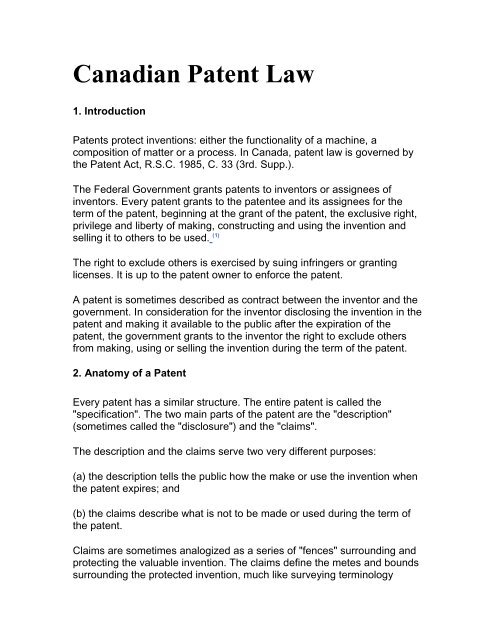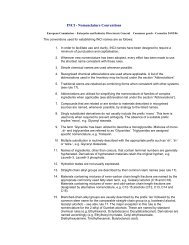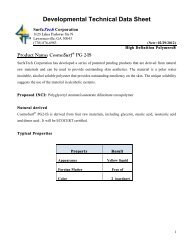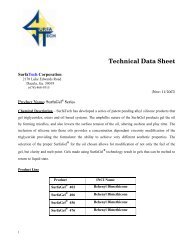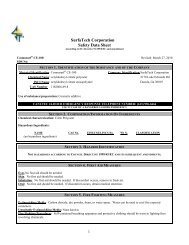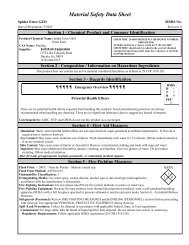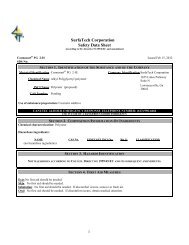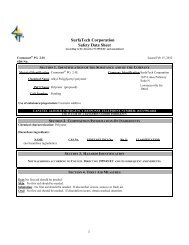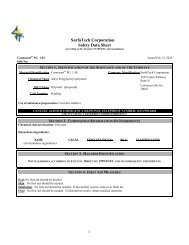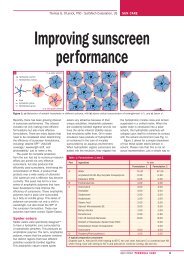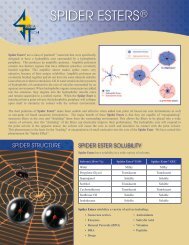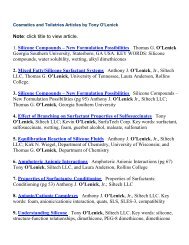Patent Law Primer - SurfaTech
Patent Law Primer - SurfaTech
Patent Law Primer - SurfaTech
Create successful ePaper yourself
Turn your PDF publications into a flip-book with our unique Google optimized e-Paper software.
Canadian <strong>Patent</strong> <strong>Law</strong>1. Introduction<strong>Patent</strong>s protect inventions: either the functionality of a machine, acomposition of matter or a process. In Canada, patent law is governed bythe <strong>Patent</strong> Act, R.S.C. 1985, C. 33 (3rd. Supp.).The Federal Government grants patents to inventors or assignees ofinventors. Every patent grants to the patentee and its assignees for theterm of the patent, beginning at the grant of the patent, the exclusive right,privilege and liberty of making, constructing and using the invention andselling it to others to be used. (1)The right to exclude others is exercised by suing infringers or grantinglicenses. It is up to the patent owner to enforce the patent.A patent is sometimes described as contract between the inventor and thegovernment. In consideration for the inventor disclosing the invention in thepatent and making it available to the public after the expiration of thepatent, the government grants to the inventor the right to exclude othersfrom making, using or selling the invention during the term of the patent.2. Anatomy of a <strong>Patent</strong>Every patent has a similar structure. The entire patent is called the"specification". The two main parts of the patent are the "description"(sometimes called the "disclosure") and the "claims".The description and the claims serve two very different purposes:(a) the description tells the public how the make or use the invention whenthe patent expires; and(b) the claims describe what is not to be made or used during the term ofthe patent.Claims are sometimes analogized as a series of "fences" surrounding andprotecting the valuable invention. The claims define the metes and boundssurrounding the protected invention, much like surveying terminology
defines the metes and bounds to a piece of land containing gold. Thefences must be clearly defined in order to give the necessary warning.Property which is not owned by the inventor must not be fenced in. (2)Claims are usually drafted with multiple, dependant claims. As such, theyare like a set of nested fences, each fence surrounding a moreparticularized form of the invention. If one of the outer most fences fails (3) ,the inner ones remain to protect the invention. The larger fences are thebroad claims; the narrowest fences are the narrow claims.Another way of considering a claim is to describe them by use of a Venndiagram, a mathematical illustration used to identify "sets". The Venndiagram of some claims would be analogous to an aerial photograph of the"fences" surrounding the invention. The claims would be a series of setsand subsets, all including the invention at the centre of the sets. Anythingthat met the description of that set, would fall inside that claim and infringeit.The invention can be described in a number of ways and therefore, therecan be different sets of claims each with dependant claims, all protectingthe invention at the core.A patent's claims can also be illustrated as a tree-structure, with branchesindicating dependency.2.1 The Title PageThe title page of a patent provides "tombstone information" concerning thepatent: the title, the inventors, the person to whom the patent was granted,the application date, the priority date, the grant date and for patents filedafter October 1, 1989, the date that the patent application was "laid open".2.2 The AbstractThe Abstract is the "headnote" of the patent, providing a summary of theinvention and its use. It includes a summary of the disclosure and indicatesthe technical field to which the invention relates. It should describe thetechnical problem and the solution of the problem by the invention. Itspurpose is to provide a succinct description of an invention so that a readercan decide whether the rest of the patent is of interest.Abstracts are now available through on-line computer databases and are
commonly used for searching the technical literature to see what areas arealready patented.2.3 The ClaimsThe claims define the monopoly in words. A patent may have many claims,each defining the invention in different words and describing it broad ornarrow functional language.the form of the claimIn Canada, an invention can be claimed in one patent in more than onestatutory class: ie. as an apparatus or a process or both. For example, aninvention may be defined by a process claim, or as an apparatus whichcarries out the process.A combination-type claim is one where the invention is described as acombination of elements or steps which achieve a desired result orinteraction.In some instances, the invention is best described by either animprovement claim (a claim where only the improvement to an existingapparatus or process is claimed), or European-style claim (one where thepreamble describes the known prior art).A claim for an apparatus should not contain a process step as an element;similarly a claim for a method should not contain an article as an element.Such claims are referred to as ones with "mixed elements". An example ofthe first type is:A digital signal processor comprising:a) a first register for storing signal data,b) transferring said signal data to a second register...You can incorporate a process limitation in a claim for an apparatus. Forexample:A computer comprising:"means for storing signal data..." or
"a first register for storing data..."The clause beginning with the word "for" describes the function or processcarried out by the apparatus.A claim can recite a process step that contains a hardware or machinelimitation. For example:A method for processing seismic data, comprising the steps of:collecting the time-varying seismic detector output signals from a pluralityof seismic sensors positioned in a cable ... [emphasis added]In the latter example, the signals are collected from a recited structure. Thestructure is the hardware or machine limitation within the process step.the preamble to the claimCombination-type claims traditionally begin with a preamble which isdesigned to identify the class of invention and recite any prior art elementswith which the invention co-operatesThe invention should be described in terms of statutory subject matter.the body of the claimIn a combination-type claim, the invention is described as a combination ofparts which interact to achieve a certain result or function. In formulating acombination-type claim, functional limitations may be expressed in"means-plus-function" format. Under U.S. practice, the court will interpretthe recited "means" as including the preferred means disclosed in thespecification as well as functional equivalents, subject to any expresslimitation in the disclosure.dependant claimsAfter drafting independent claims in one or more statutory classes, thepatent agent usually then drafts a number of dependent claims for definingsubordinate features to those recited in the independent claims or tofurther define features and/or structure of the essential claim elements.3. The Description (Disclosure)
The nature of the invention must be defined in the disclosure and themanner in which the invention is to be carried out, must be described. Inthe case of a machine (for example, a computer), the best mode ofoperation must be described. In the case of a process (for example, theimplementation of an algorithm by computer process), the necessarysequence of steps must be explained for distinguishing the invention fromthe prior art. (4)The description is like a manual that accompanies a kit such as a homebarbecue. In the case of a patent for an apparatus, it includes a parts listidentifying the parts needed to make the apparatus and assemblyinstructions explaining how to put the parts together. This description isused as a cross-reference to a series of drawings bearing numberscorresponding to the parts illustrating how the device is put together.Operating instructions explain how to use the device in the best mannerknown.The description must describe the invention and its uses contemplated bythe inventor. (5) The description must be clear, accurate, simple and easy tounderstand by the person or persons to whom the patent is directed,namely the skilled workers in the relevant field (See Claim Construction).3.1 the body of the descriptionThe disclosure is usually divided into the following sections;(a) the Area of the Invention,- a general description of the field of the invention;(b) a description of the prior art and their problems,- what solutions existed in the past to similar problems and what problemswere not overcome by the prior art;(c) the Object of the Invention,- this describes the desired results of the invention. A statement of theobject of the invention is not mandatory and is sometimes dangerous toinclude because all claims must meet the object or they will fail for beingtoo broad; (6)
(d) the Consistory Clause,- a generalized description of the invention. Usually the language from thebroadest claim is restated to make the description consistent with thebroadest claim;(e) the description of the preferred embodiment of the invention,- an example of an implementation of the invention. Usually the bestversion of the invention known at the time that the patent application wasfiled. It is described with reference to the drawings;(f) a description of further embodiments; and(g) a generalised statement that the embodiments are illustrative and notlimiting,- an attempt by the inventor to let everyone know that the monopoly is notlimited to the embodiment shown in the patent.3.1 the drawingsThe disclosure must also refer to any drawings forming part of theapplication. Many patent agents begin sketching informal or conceptualprecursors to the formal drawings while drafting the claims and thenfinalize the drawings while drafting the description.If certain information that is not otherwise publicly available is needed inorder to make or use the invention, then it must be included in thedescription or else the patent will be declared invalid for failing to describethe best mode of operation of the invention or its necessary sequence ofsteps. (7)4. International Agreements Affecting <strong>Patent</strong>sCanada is a signatory to several international Agreements or Conventions.4.1 The Paris Convention - 1883In 1883, under the Paris Convention, several countries agreed to providetreatment under their intellectual property statutes equally to nationals of
other countries.The Paris Convention also provided for what is known as "conventionpriority": if you file an patent application in one country, you have a certainperiod of time (1 year for patent applications) within which to file anapplication in other member countries. The subsequently filed applicationsare treated as if they were filed on the same day as the first-filedapplication. In effect, the subsequent applications are back dated.The ability to file only one application and to file subsequently furtherapplications based upon it is of critical importance in planning a patentfiling strategy for obtaining patent protection around the world.There are over 120 countries which have ratified the Paris Convention.The Paris Convention is administered by the World Intellectual PropertyOrganization ("WIPO"), based in Geneva, Switzerland.4.2 World Trade OrganizationThe World Trade Organization was created out of the Uruguay Round ofthe General Agreement on Tariff and Trade ("GATT"). The GATT wasintended to decrease trade barriers between countries.Ironically, the Trade Related Aspects of Intellectual Property ("TRIPS"),had the effect of improving intellectual property protection in mostcountries (8) making Intellectual Property a non-tariff trade barrier.Under the North American Free Trade Agreement ("NAFTA") and GATT,Canada imposed upon itself (as did other signatory countries) an obligationto make patents available for "any inventions ... in all fields of technology".(9)There is to be no discrimination as to the field of technology unless it is asort of technology that fits under a specific exclusion. Software-relatedinventions are not excluded.4.3 <strong>Patent</strong> Co-operation TreatyThe <strong>Patent</strong> Co-operation Treaty ("PCT") is a multi-lateral treaty that cameinto force in 1978. It facilitates filing patent applications in the PCTcontracting States which includes most developed and many underdevelopedcountries.
The PCT allows for the filing of one patent application (an internationalapplication) in which the applicant expresses the intention to have nationalor regional patent applications filed in the indicated States or Regions. Thecost of translations and national filing fees are postponed until 20 or 30months after the priority date. Examination of the application is available atthe request of the applicant.The advantages of a PCT application are that only one patent applicationneed be filed which can designate on the prder of 100 countries. Theapplication is filed in one language thereby deferring translation fees. Thecost of filing in the individual countries is deferred until later.5. Statutory Subject MatterThe Canadian <strong>Patent</strong> Act (10) , provides that patent protection may beacquired for any "invention", defined under s. 2 as follows:"invention" means any new and useful art, process, machine, manufactureor composition of matter, or any new and useful improvement in any art,process, machine, manufacture or composition of matter;subject to the prohibition of ss. 27(8) that:"No patent shall issue for ... any mere scientific principle or abstracttheorem."There are three pre-requisites to patentability:(a) novelty,(b) utility, and(c) non-obviousness. (11)In order for there to be an invention, there must be both a concept and animplementation (a way of putting the concept into practical form). (12) It isnot enough to have an idea floating through an inventor's brain. Theinventor must have at least reduced it to a definite and practical shapebefore it can be said that an invention has been made. (13) The date aninvention is made is established by showing that the invention was eitherdescribed in enabling writing (or drawing) or built. The machine does nothave to be built; that is merely one way of establishing a date of invention.
(14)5.1 NoveltyFor a invention to be patentable, it must be "new". (15) In order to be novel,the invention must not have been done before in a way that was availableto the public. (16)The invention need not be revolutionary but can be a combination of oldthings. So long as the combination is new, the invention is novel. (17)In order to be novel, the invention must not have been built before ordescribed in a single document with contained sufficient information toallow someone to make the invention. (18)The new placement side-by-side of old devices, so that each deviceperforms its own functions independently of the others, does not constitutean invention. (19) Where each element functions independently, and there isno common result, then there is no inventive combination. (20) The merejuxtaposition of parts is insufficient. Elements must combine for a unitaryresult. If any element in the arrangement gives its own result without anyresult flowing from the combination, then there is no invention. (21)<strong>Patent</strong>s are available for improvements to existing machines or processes.It must be appreciated however, that the patent to an improvement doesnot grant the patent owner any right to use the underlying technology,which may be patented by the original inventor.5.2 UtilityIn order to be protectable by a patent, the invention must be "useful". (22)The invention must be useful for the purpose for which it was designed. (23)An invention has utility if:(a) it gives a benefit to the public;(b) it is useful in achieving a particular purpose;(c) it makes a process better or cheaper;
(d) it is advantageous under certain circumstances; and(e) it works.Older case law held that an invention had to result in a "vendible product"in order for it to be patentable. The trend in other jurisdictions and inCanada is now drifting towards the requirement that the inventionproduced a "technical result".5.3 Non-Obviousness or IngenuityThrough the case law, and now by statute, the Courts added therequirement of non-obviousness or Inventive Ingenuity. This arose out of adesire by the Courts not to allow a patent to cover any routineimprovement. In the Edison Bell case, (24) the court described it this was:"It really comes to this, that, although the invention is new - that is, thatnobody has thought of it before - and although it is useful, yet, when youconsider it, you come to the conclusion that it is so easy, so palpable, thateverybody who thought that for a moment would come to the sameconclusion; or, in more homely language, hardly judicial, but ratherbusiness-like, it comes to this, it is so easy that any fool could do it."That requirement has now been incorporated into the Canadian <strong>Patent</strong> Actunder section 28.3.An invention is sometimes identified by its measure over the prior art. Thecomparison is made between what was invented and what has taken placebefore hand. The courts have sometimes said that there is a quantum leapor spark ("scintilla") of invention.The test for inventiveness has been very difficult to articulate."Nobody however, has told me, and I do not suppose anybody ever will tellme, what is the precise characteristic or quality the presence of whichdistinguishes an invention from a workshop improvement. Day is day, andnight is night, but who shall tell where day ends or where night begins?" (25)Some cases state that an invention is the result of inventive skill, whichdefinition, begs the question to raise a further one: what is inventive skill?(26)Thus an invention is some thing created by an inventive mind. Thecorollary is that someone without any inventive abilities would create
something obvious.The test for inventiveness in Canada has now evolved to asking whetherthe invention would have been obvious to a hypothetical individual,possessed of all the relevant prior art but what lacked any inventiveabilities. Would that person have been led directly and without difficulty tothe solution disclosed and claimed in the patent? (27)6. The Application ProcessA patent application, in the form of a draft patent is filed with theappropriate governmental department, the application is a draft copy of thepatent desired.In order to obtain a patent, three things are required:(a) an inventor;(b) an invention described in an application; and(c) money.6.1 An inventorYou have no right to protect an invention unless you are the inventor, orhave obtained title to the invention from the inventor. (28) The person orpersons applying for the issue of a patent is the Applicant. (29) The patentcan also be applied for by the "legal representative" of an inventor who isanyone who has assumed ownership of the patent by operation of law orby assignment. (30) In the United States, only the Inventors can apply for apatent.<strong>Patent</strong>s can be assigned, in whole or in part by written document. (31) Theco-owner of a patent cannot subdivide his part ownership into two or moreparts without the concurrence of all the owners of the patent. (32)The first assignment filed with the Canadian <strong>Patent</strong> Office governs. (33)First-to-File versus First-to-InventUntil the late 1980's, Canada followed the American model of awardingpatents to the first person or persons to have invented the invention. The
United States still follows this "first-to-invent" system. This policy can resultin disputes arising between inventors requiring them to prove who inventedwhat first (called "conflicts" in Canada and "interferences" in the UnitedStates).In the late 1980's, Canada switched to a first-to-file system (34) whichresulted in the patent being awarded to the first inventor to file a patentapplication for the invention. (35) In the first-to-file system, inventors areencouraged to file their patent applications as quickly as possible or elserisk having someone else, another inventor, file first.6.2 The ApplicationThe invention is described and claimed in a <strong>Patent</strong> Application, whichlooks like the patent that the Applicant wishes to have issued.The <strong>Patent</strong> Application is accompanied by the documentation requestingthe grant of a patent (called the "Petition") and material evidencing theauthority of the person applying for the patent. <strong>Patent</strong>s are usuallyprosecuted by patent agents on behalf of the inventor or the assignee.Usually prior to filing the <strong>Patent</strong> Application, a search is done in the <strong>Patent</strong>Office to find relevant prior art in the area. After the search is done, the<strong>Patent</strong> Agent gives the client an opinion as to the likely scope or protectionavailable. The patentability search mimics the search done later by theexaminer in the <strong>Patent</strong> Office, during the prosecution stage (seeProsecution below).ProsecutionOnce the <strong>Patent</strong> Application is filed, the applicant has seven years fromthe Canadian filing date (for applications filed prior to October 1, 1996) or 5years (for applications filed after October 1, 1996) to request that thepatent application be examined.The Examiner then reviews patents or <strong>Patent</strong> Application on file in theCanadian <strong>Patent</strong> Office in the same or related areas. Any other literaturepublicly available is also available to the Examiner. There is a statutoryobligation to provide prior art which is available to other <strong>Patent</strong> Offices, ifrequested. (36) Otherwise, there is no obligation to disclose prior art to theCanadian <strong>Patent</strong> Office. In the United Sates, however, there is a positiveobligation to present relevant art to the U.S. <strong>Patent</strong> Office. Not to do so can
esult in the issuance of an invalid patent.The "Office Action"After reviewing the application, the Examiner may conclude that theApplicant needs to amend the application and will issue a letter to theApplicant setting out the objections. The letter is referred to as an "officeaction". (37) Time limits are imposed within which a response must be filed tothe office action.Laying Open of the ApplicationUnder the first-to-file systems, <strong>Patent</strong> Applications are laid open for publicinspection or published no later than 18 months from the filing of the first<strong>Patent</strong> Application for the invention. The Applicant can request earlierpublication if desired. (38) The publication of a <strong>Patent</strong> Application, in effect,warns the public that a patent may issue for the technology. If a patentsubsequently issues, the patent owner is entitled to "reasonablecompensation" for any "infringements" done between the date of thepublication of the patent and the issue date of the patent and to profits ordamages thereafter. (39)6.3 MoneyIn addition to filing fees, annual fees must be paid in order to maintain apatent or patent application or else it will be deemed to have beenabandoned. (40) Maintenance Fees are due after the first anniversary datein Canada and before the second anniversary. Small entities paymaintenance fees half that of large entities. (41)Maintenance fees are payable on all patents that issued after October 1,1989. (42)7. Claim ConstructionIn order to determine whether a claim is infringed or invalid, the first duty ofa Court is to read the claims and give them meaning (a process referred toas "claim construction"). Multi-million dollar lawsuits can be won or lostdepending on the upon the meaning of a word or two in a claim. (43)The construction of a patent is a legal exercise. (44)Likewise, in the United
States, the construction of the claims is the job of a judge not the jury.The job of the court is to interpret the claims. It cannot redraft them. (45)7.1 The AddresseeThe court is to construe the patent as would a person skilled in the art towhich the patent is directed because the claims are addressed to theskilled worker, not to the lay person (46) or persons.The patent is to be interpreted as of the date it issued. (47)A patent should be given a reasonable and fair construction, clear to boththe patentee and the public. (48)In construing the claims of the patent, the words should be given theircommon ordinary meaning and reference should be made to thedisclosure only;(a) to assist in understanding terms used in the claims, particularly wherethe disclosure is used as a dictionary; or(b) where the words of the claim are not plain and unambiguous. (49)It is not permissable to make reference to the disclosure to vary the scopeor ambit of the claims. (50)7.2 File Wrapper EstoppelThe "file wrapper" is the name given to the file in the <strong>Patent</strong> Officecontaining the correspondence between the inventor's patent agent andthe <strong>Patent</strong> Office examiner during the prosecution of the patent. Itsometimes contains statements made on behalf of the inventor of what theinventor considers the invention to be and how it differs from the prior art.Extrinsic evidence is not admissible for construing a patent. Evencomments made on behalf of the inventor during the prosecution of thepatent cannot be used in Canadian courts to interpret the words in theclaim. (51) In the United States however, the "file wrapper end" can be usedand patent owners can be estopped from asserting facts as different thanas represented during the prosecution process.
8. InfringementInfringement is any act that interferes with the full enjoyment of themonopoly granted. (52)Infringement of a patent occurs when the words of a claim, as construedby the court, aptly describe the defendant's product or process.8.1 Intent to InfringeIn Canada, it does not matter whether a defendant intended to infringe thepatent; the defendant will still be liable for damages or profits. (53)In the United States, however, a defendant will be penalised for wilfullyinfringing a patent or carrying on with reckless disregard to the situationand trouble damages can be awarded. (54)8.2 Literal or Textual InfringementIf each and every word of the claim aptly describes the defendant's articleor process, then there is little or textural infringement. (55) The claim formsthe basis for the comparison, like a checklist. The elements of a claim arecompared with the elements of the defendants device or process.8.3 Infringement of the Pith and SubstanceOlder cases stated that a patent could still be infringed if there was noliteral infringement but if the defendant had made minor variations to theinvention and had still taken the substance of the invention. (56) The courtsdistinguished between the "essential elements" in a claim and the nonessentialelements which could be varied. Non-essential integers could beomitted or replaced by their mechanical equivalents and there would stillbe infringement. (57)8.4 Substantive InfringementIn 1982, the English House of Lords decided the case of CatnicComponents Ltd. v. Hill & Smith Ltd.. (58) The Catnic test, like the pith andsubstance test, applied where there was a variant between what the claimstated and the defendants device or process. The Catnic test is:
(a) Does the variant have a material effect on the way the invention works?(b) If it does not, does the patent specification make it obvious that thevariant was not intended to be excluded from the claim? (59)The answer to the second question must be consistent with the text of theclaims. The court must interpret them, it cannot redraft them.Where an inventor has clearly stated in the claims that he considered arequirement as essential to the invention, the court cannot decideotherwise for the sole reason that he was mistaken. The court cannotconclude that strict compliance of the word or phrase used in the claim isnot an essential requirement of the invention unless it is obvious that theinventor knew that a failure for complying with that requirement would haveno material effect upon the way the invention worked. (60)9. RemediesThe <strong>Patent</strong> Act provides that an infringer will be liable for damages andprofits (61) and can be ordered to no longer make, use or sell the infringingdevice or process.Endnotes1. <strong>Patent</strong> Act, s. 422. Minerals Separation North America Corporation v. Noranda Mines Ltd.[1947] Ex. C.R. 306 (per President Thorson) at pp. 322-323 affirmed(1949), 12 C.P.R. 99 per Kelloch J. at p. 202 (S.C.C.).3. See Validity.4. <strong>Patent</strong> Act, s. 41.5. <strong>Patent</strong> Act, s. 34(1).6. See Defects in the Disclosure.7. Ductmate Industries Inc. v. Exanno Products Ltd. (1985) 2 C.P.R. (3d)
289 (F.C.T.D. per Reed J.).8. The term of a patent was agreed to be increased to 20 years from thedate of filing.9. Title 17 excluded certain biotechnology but did not affect computerrelatedinventions.10. R.S.C. 1985, c. P-4, as amended.11. <strong>Patent</strong> Act, s. 28.3.12. Reynolds v. Herbert Smith & Co. Ltd. (1903), 20 R.P.C. 123 (perBuckley J.) at p. 127; Diversified Products Corp. v. Tye-Sil Corp. (1991),35 C.P.R. (3d.) 350 (F.C.A. per Décarry J.) at pp. 364-5.13. Permutit Co. v. Borrowman [1926] 4 D.L.R. 285, 43 R.P.C. 356 (P.C.).14. Owens-Illinois Inc. v. Koehring Waterous Ltd. (1981), 52 C.P.R. (2d.) 1(F.C.A.) at p. 2.15. <strong>Patent</strong> Act, s. 2.16. <strong>Patent</strong> Act, s. 63.17. Philco Products Ltd. and Cutten-Foster & Sons, Limited v. ThermionicsLimited et. al. [1943] S.C.R. 396 (per Taschereau, J.) at pp. 412-413;Canadian General Electric Co. Ld. v. Fada Radio Ltd. (1930), 47 R.P.C. 69(H.L.) at p. 90.18. Sometimes called an enabling disclosure.19. British Celanese v. Courtaulds (1935), 52 R.P.C. 171 at p. 193.20. Lester v. Commissioner of <strong>Patent</strong>s (1946), 6 C.P.R. 3.21. Domtar Ltd. v. McMillan Bloedel (1977), 33 C.P.R. 182 (F.C.T.D.) at p.189-90.22. <strong>Patent</strong> Act, s. 2.23. Mullard Radio Valve Co. Ltd. v. Philco Radio & Television Corp. of
Great Britain Ltd. et. al. (1935), 52 R.P.C. 261 (per Maugham O.J.) at p.287.24. The Edison Bell Phonograph Corporation, Limited v. Smith and Young(1894), 11 R.P.C. 389 at p. 398.25. Samuel Parkes & Co. Ltd. v. Crocker Bros. Ltd. (1929), 46 R.P.C. 248(per Tomlin J.) at p. 248.26. Canadian Gypsum Co. Ltd. v. Gypsum, Lime and Alabastine CanadaLtd. [1931] Ex. C.R. 180 (per MacLean J.) at p. 187.27. See Beloit .28. <strong>Patent</strong> Act, s. 27.29. <strong>Patent</strong> Act, s. 2.30. <strong>Patent</strong> Act, s. 2.31. <strong>Patent</strong> Act, s. 50 (1).32. Georgina Forget v. Specialty Tools of Canada Inc. (1993), 48 C.P.R.(3d.) 323 (D.S.C.S. per Rowan J.); affirmed on appeal.33. <strong>Patent</strong> Act, s. 50(2).34. Affecting all patent applications filed on or after October 1, 1989.35. <strong>Patent</strong> Act, s. 27(1)(a) and (b).36. <strong>Patent</strong> Act, s. 35(4).37. <strong>Patent</strong> Rules, s. 45(1).38. <strong>Patent</strong> Act, s. 10(2).39. <strong>Patent</strong> Act, s. .40. <strong>Patent</strong> Act, s. 27.1(2).41. See definition of small entity
42. <strong>Patent</strong> Rule, 80.1(1) and(3).43. Electrical and Musical Industries, Ltd. and Boonton ResearchCorporation, Ld. v. Lissen, Ld. and another (1939), 56 R.P.C. 23 (per LordRussell of Killowen) at p. 39.44. Western Electric Co. et al. v. Baldwin International of Canada (1934),4. D.L.R. 129 at p. 133, [1934] S.C.R. 570 at p. 574 (S.C.C. per Duff C.J.).45. O'Hara Manufacturing Ltd. et al. v. Eli Lily & Co. et al. (1989) 26 C.P.R.(3d.) 1 (F.C.A. per Pratte J.A.) at p. 7.46. Burton Parsons v. Hewlett Packard (1975), 17 C.P.R. (2d.) 97 (S.C.C.per Pigeon J.) at p. 104. See also American Cyanamid Company v.Ethicon Limited [1979] R.P.C. 215 (per Graham, J.) at pp. 245-246.47. AlliedSignal Inc. v. Dupont Canada Inc. et al. F.C.A.48. Consolboard Inc. v. McMillan Bloedel (Sask.) Ltd. [1981] 1 S.C.R. 504at pp. 520-521 per Dickson J.49. Beecham Canada Ltd. v. Procter & Gamble Co. (1982) 61 C.P.R. (2d.)1 per Urie J.A.50. Dableh v. Ontario Hydro, Federal Court of Appeal.51. Lovell Mfg. Co. et al. v. Beatty Bros. Ltd. (1962), 41 C.P.R. 18 (Ex. Cd.per Thorson P.)52. Skelding v. Daly et al. (1941), 2 Fox P.C. 61 (D.C.C.A. per O'HalloranJ.A.) at p. 68.53. Skelding v. Daly, et al. (1941), 2 Fox P.C. 61 (D.C.C.A. per O'HalloranJ.A.) at p. 6854. Corning Glass v. Sumitomo Electric 5 U.S.P.Q. 2d. 1545 p. 1570-1571.55. Lovell Mfg. Co. et al. v. Beatty Bros. Ltd. (1962), 41 C.P.R. 18 (Ex. Ct.per Thorson P.).56. McPhar Co. v. Sharpe Instruments 21 Fox Pat. C. 1 (Ex. ct. perThorson P.) at pp. 55-59.
57. Rodi & Wienenberger [1969] R.P.C. 367 per Lord Upjohn at p. 391.58. (1982), R.P.C. 183 (H.L.)59. See also Improver Corp. v. Remington Consumer Products Ltd. [1989]O.P.C. 69 at p. 7860. O'Hara Manufacturing Ltd. v. Eli Lily et al. (1989), 26 C.P.R. (3d) 1(F.C.A. per Pratte J.A.) at p. 6-7.61. <strong>Patent</strong> Act, s. 52.


